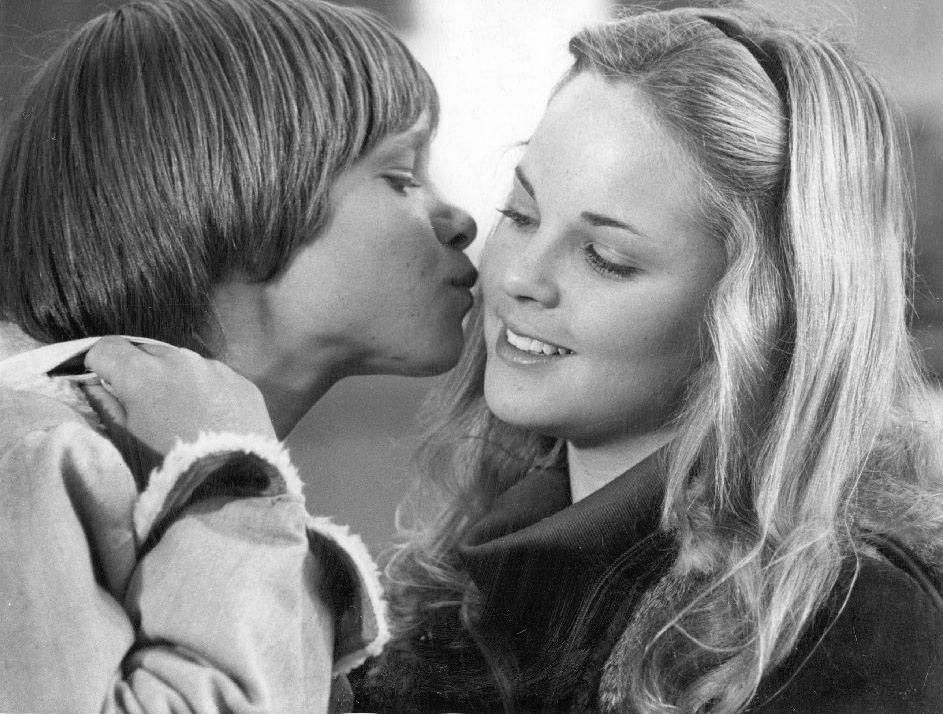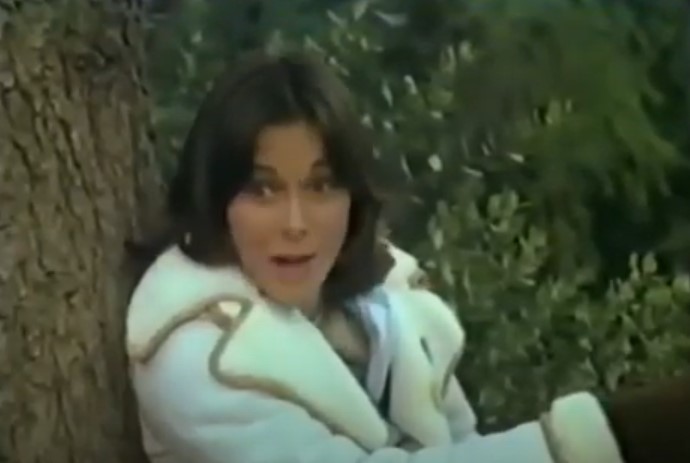James at 15 premiered on NBC before my 10th birthday, but I was the kind of kid — I think a lot of us were — who craved TV that seemed more grown-up than I was. In fact, looking it up right now, I see that Soap premiered on ABC eight days later, and that might well have been the most controversial series of the 1970s, or at least since the debut of All in the Family. I remember watching a report about Soap on Eyewitness News earlier that evening, warning of the risqué material, but that didn’t keep me from watching the first episode that night. I don’t know if I’ve mentioned it here before, but when we moved into our new house in Woodland Hills in late 1972, just as I was turning 5, the three Weisman kids each got their own bedrooms and their own TV sets. For real. Yes, we had it good.
But I digress. James at 15 was a big deal for me, maybe the way The Wonder Years would turn out to be for kids a decade later. (The Wonder Years was a big deal for me as well, but for different reasons.) Only 3 1/2 years after The Brady Bunch, the iconic show of my childhood, went off the air — to my tears when I heard the news — James at 15 came on as what appeared to be a sneak preview of my adolescence. James was a nerd, a goofball, a Walter Mitty-style fantasist, and he was also girl-crazy. I wasn’t really like James, outside of almost sharing the same unfortunate haircut, but I think I could subconsciously infer how my certain kind of desperation might dovetail with his.
 I can’t remember if I watched the premiere episode the night it aired because my older brother was, or if I found it on my own. Either way, I have little doubt that my path to having interest in the show was paved by Melissa Sue Anderson, the Little House on the Prarie co-star who played Lacy, James’ first big crush. Anderson didn’t quite hold the supreme aura of a Maureen McCormick or Valerie Bertinelli for 9-year-old me, but it was still exciting to see her in a modern-day role that was not quite so wholesome as Mary Ingalls. In fact, James (played by another actor known to me, former Little House guest star Lance Kerwin, who was fresh off playing a young character based on Michael Landon’s childhood bedwetting experiences in The Loneliest Runner, a film in which I appear in a crowd scene shot during halftime of a Rams game at the Los Angeles Memorial Coliseum) (how’s that for a parenthetical?) and Lacy clearly come thisclose to having sex about midway through the episode, before they stop because … well, because it’s cold outside, which doesn’t really make any sense. I don’t know how deeply I took in the implications of them getting inside a sleeping bag and tossing their clothes out, but I knew something was up.
I can’t remember if I watched the premiere episode the night it aired because my older brother was, or if I found it on my own. Either way, I have little doubt that my path to having interest in the show was paved by Melissa Sue Anderson, the Little House on the Prarie co-star who played Lacy, James’ first big crush. Anderson didn’t quite hold the supreme aura of a Maureen McCormick or Valerie Bertinelli for 9-year-old me, but it was still exciting to see her in a modern-day role that was not quite so wholesome as Mary Ingalls. In fact, James (played by another actor known to me, former Little House guest star Lance Kerwin, who was fresh off playing a young character based on Michael Landon’s childhood bedwetting experiences in The Loneliest Runner, a film in which I appear in a crowd scene shot during halftime of a Rams game at the Los Angeles Memorial Coliseum) (how’s that for a parenthetical?) and Lacy clearly come thisclose to having sex about midway through the episode, before they stop because … well, because it’s cold outside, which doesn’t really make any sense. I don’t know how deeply I took in the implications of them getting inside a sleeping bag and tossing their clothes out, but I knew something was up.
And that was the thing about TV in the 1970s. With only three networks, four independent channels (in Los Angeles: KTLA 5, KHJ 9, KTTV 11 and KCOP 13) plus PBS (KCET 28), it was truly a broadcast medium. That meant you wouldn’t see the kind of R-rated stuff you find across the board today, but it also meant the G-rated stuff might be a little randier than what you see on programming targeted for kids today (underscore “targeted”). We 1970s kids definitely got a glossier view of the world in TV than we would today, but we also I think found our way to worthwhile but challenging subject matter that might be harder to navigate today. Disney Channel, for example, doesn’t air anything like James at 15 (let alone Soap). The most famous episode of the series, actually, takes place on James’ 16th birthday (yes, the show memorably changed its title that night), when James does lose his virginity. This drew more news coverage questioning its sanity, but it was there for everyone to see. The Afterschool Special-style programming of the 1970s often gets mocked, but there was something to said about its earnestness and sensitivity.
I will say that I had higher hopes for rewatching James at 15 this week than what I got. Some of it is just so cringeworthy — I guess that’s to be expected, but it was more painful than I was ready for. (The pilot of The Wonder Years, by contrast, remains just about a perfect episode of television.) But there are also moments where you really appreciate what the show is trying to do, and moments where they find nuances of teenage angst and uncertainty that few other shows landed upon, before or since.
 In the second half of the episode (two hours of running time, including commercials), James runs away from home, ends up hitchhiking (yes, 1970s) and forms a friendship with a character played by none other than Kate Jackson, kind of a shocking bit of casting considering that she was entering her second year of galactic fame thanks to Charlie’s Angels. (The second-season premiere of Charlie’s Angels aired a night after the Soap premiere. Fred Silverman, take a bow.) For all my Melissa Sue Anderson excitement, the stuff between Jackson and Kerwin is really the most enduring part of the pilot. She’s too good to be true, but she’s able to school him in life the way no one he encounters has been able to do — certainly not his annoying parents, and not even his lovable kid sister (more than deserving of mention, because she’s played by Nanny and the Professor, Escape to Witch Mountain, Hello Larry and Tuff Turf legend Kim Richards). Jackson scored an Emmy guest drama actress nomination for her efforts.
In the second half of the episode (two hours of running time, including commercials), James runs away from home, ends up hitchhiking (yes, 1970s) and forms a friendship with a character played by none other than Kate Jackson, kind of a shocking bit of casting considering that she was entering her second year of galactic fame thanks to Charlie’s Angels. (The second-season premiere of Charlie’s Angels aired a night after the Soap premiere. Fred Silverman, take a bow.) For all my Melissa Sue Anderson excitement, the stuff between Jackson and Kerwin is really the most enduring part of the pilot. She’s too good to be true, but she’s able to school him in life the way no one he encounters has been able to do — certainly not his annoying parents, and not even his lovable kid sister (more than deserving of mention, because she’s played by Nanny and the Professor, Escape to Witch Mountain, Hello Larry and Tuff Turf legend Kim Richards). Jackson scored an Emmy guest drama actress nomination for her efforts.
The soundtrack of James at 15 speaks volumes about the show and its era — Cat Stevens, Seals & Crofts, England Dan & John Ford Coley. This was a series airing when AM radio was still playing the hits and FM was an upstart. Just look at the shows airing that season: not only madcap comedies like Happy Days, Laverne & Shirley and Three’s Company, but also earnest, issue-centric programs like Eight Is Enough, One Day at a Time, M*A*S*H, Alice and What’s Happening!! I even have strong memories of a short-lived series, What Really Happened to the Class of ’65?, which was dark and I probably had no business watching, but watch I did, because it was so compelling to someone trying to learn all he could about the world. We children of the ’70s weren’t quite ready to cross in to the unshackled 1980s, but we were on our way. For a young TV viewer, it was a great time to be alive.




Comments are closed.